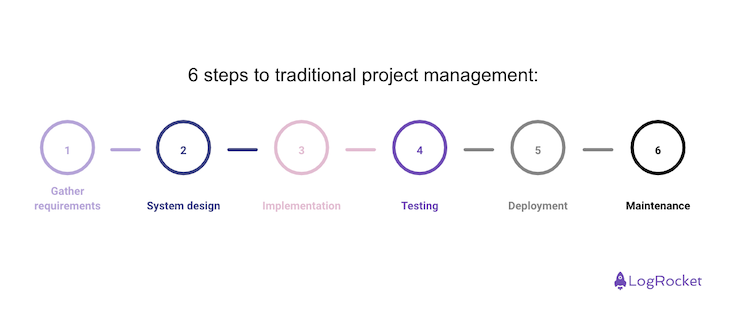Having a process that product teams can follow to deliver projects on time is critical. However, there are several approaches a team or organization can take and they all have their own unique pros and cons. The main two processes teams use to bring their products and solutions to market are traditional and agile project management.

While traditional project management was the forerunner for decades, agile quickly became popular in the 90s as team size and bandwidths decreased and customer demands increased. Agile was an appealing approach because it gets product into customers hands faster and has a core focus on teams and customers.
In this article, you will learn more about agile project management, including its benefits and popular tools.
In product management, there are generally four main approaches teams take to manage their projects and roadmap: the traditional or “waterfall” approach, lean project management, six sigma, and agile project management. The approach a team chooses depends on the project itself and the company’s preferred way of operating.
Remember that one approach is not necessarily superior to the other. Oftentimes organizations will adopt a hybrid approach combining two or more of these methods to fit their teams needs.
So how do you determine which approach is right for your company, team or project?
For the purpose of this article, we are going to hone in on two of the four approaches commonly used in organizations:
The traditional “waterfall model” for project management has been around for decades. Traditional project management gained momentum in the manufacturing and construction industries and later was applied to Tech.
As part of traditional waterfall projects, requirements are heavily documented up front and a project is broken down into specific phases. Each of the phases can begin only after the previous phase has been completed and delivery happens when all of the phases have been met. Think of it this way, if you are designing a car you can’t build the steering wheel or add the seats in before you have built out the frame. There is a logical order to which things are built and traditional helps streamline that process.
There are six main phases in traditional project management:

Moving from phase one to phase six can take months, if not years depending on project size and timeline. The amount of documentation required before any coding starts is immense. Oftentimes, value can be provided to customers earlier than project completion and in smaller increments.
This is where agile project management comes in…
Once the internet came around, a lot of the teams working on software found themselves operating in small, co-located teams. They faced financial and competitive pressure to produce value to their customers faster. New tools to use started to rapidly increase.
The way teams were adapting to work to meet these demands started to drift from the more rigid traditional process. These teams were starting to operate using a flexible or agile project management approach and they didn’t even know it!
Formally introduced in 2001, agile was created when 17 technologists realized the new way they were operating due to constraints allowed them actually to move quicker and deliver software faster. As part of their discovery they documented their approach to share with others in what they called, the Agile Manifesto. The Agile Manifesto is centered around four major principles and places emphasis away from the deliverables themselves and onto the individuals and the teams building them. These four principles include:
Agile puts a focus on people and deliverables over process and documentation. Therefore agile project management can be defined as an iterative approach to delivering projects.
Agile teams are small in nature and primarily consist of the following roles: scrum master or agile project manager (APM), product owner, and development team.
There are a lot of great benefits to choosing agile over traditional project management. In the past ten years working in software development, I have used agile methods a majority of the time and love it. Why wouldn’t you want to get working software out quickly to your customers so they can begin benefiting immediately while still getting their feedback?
Some of the key benefits include:
Yes, there are cons to this approach. Often in the spirit of moving fast, items are shipped half-baked and due to a number of competing priorities are sometimes left that way for months if not years. However, there is so much you and your team can learn from the iterative approach agile offers that the pros far outweigh the cons.
As I mentioned above there are a variety of roles that make up an Agile scrum team. One of the most important roles is that of the agile project manager, often called the scrum master. This role is critical to the success of the team. They act as the glue that holds it all together.
The key responsibilities of the agile project manager (APM) include:
Some APM’s serve multiple teams. They often wear many hats and those hats can evolve based on the individual team setup.
But what good is a stellar team if you don’t have great tools to help you navigate your project’s development?
There are many tools out there marketed to agile teams to help streamline and track the flow of work. Here’s my personal top 3 favorites:
Jira by Atlassin is a comprehensive, technical project management tool. I’ve used Jira in every company I have built products for. It’s great for technical organizations of really any size.
Jira allows for teams to manage projects starting with the high roadmap view all the way down to the individual task level. It offers incredible cross-linking dependencies options and advanced reporting (think burndown charts etc) so that you can really understand how individual teams and the organization are performing.
Jira also integrates with a lot of external apps commonly used in product management like Salesforce, Confluence, Slack and Productboard making day to day work seamless across apps.
Asana is another great tool not only for product teams but marketing teams as well. Asana allows its users to craft detailed project plans and assign tasks from the project with due dates to outside parties keeping everyone accountable.
Asana provides detailed reporting on project plans and overall team performance so that it’s clear to stakeholders where a project is in its time frame and how individual teams are performing.
Basecamp is a project management collaboration tool that’s great for smaller companies and teams. It offers a lot of the great benefits a tool like Jira offers to organize and track progress on projects and the tasks that fall under them, as well as a plethora of integrations with tools like Slack, Google Docs, Figma, and more.
What sets Basecamp apart from Asana and Jira are the collaboration features. Yes all three offer a way to communicate on issues via comments or assigning tasks, however Basecamp goes deeper by offering “campfire” chats, automatic team check ins, and a message board to pitch ideas, post announcements, and more.
Ok great, so Agile seems like something you want to try and there are some really cool tools to introduce to your team as part of this. How do you make the switch from the traditional approach to agile?
Shifting mindsets and training will be key. If you recall from above, traditional is a very heavy process and documentation focused approach versus agile which is about teams, mentorship, and a quick iterative approach to releasing software. So education and communication of the benefits is essential in getting organizations and teams on board.
I suggest not trying to change everything all at once, especially because the Agile approach is so different from traditional project management. The best way to start making the change is to identify an upcoming project that might be a good candidate for this iterative, fast value to customers approach.
Use it as your proof of concept. If you can prove with a project that this process works and produces better results it will give you more ammo to use to make the case to use agile widely.
The Project Management Institute has a great paper they put out on making the transition to agile worth reading if you are considering moving to this approach.
Both traditional and agile project management have their pros and cons. However, agile serves as a much more streamlined approach that puts the team and the customer at the center of the project and allows for value to customers at a quicker pace. It’s flexible and allows for changes that naturally can occur over the course of a project.
Having an agile project manager leading the team is an essential piece to ensuring success of your project. Once your team and organization align around agile there are a lot of great project management tools out there to make the process seamless.
Featured image source: IconScout

LogRocket identifies friction points in the user experience so you can make informed decisions about product and design changes that must happen to hit your goals.
With LogRocket, you can understand the scope of the issues affecting your product and prioritize the changes that need to be made. LogRocket simplifies workflows by allowing Engineering, Product, UX, and Design teams to work from the same data as you, eliminating any confusion about what needs to be done.
Get your teams on the same page — try LogRocket today.

A practical framework for PMs to use AI in ideation without sacrificing judgment, strategy, or decision quality.

A practical five minute revenue estimation method to help product managers compare ideas, drop low impact features, and prioritize smarter.

A practical guide for PMs who want to stop being bottlenecks, delegate smarter, and lead teams effectively with a clear ownership framework.

Stop letting unreliable data block features. Treat data as inventory to track quality, ownership, and ship with confidence.